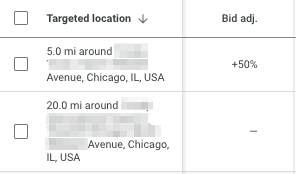Bid Multipliers and Bid Adjustments: How to Optimize Your Ad Campaigns
What are bid multipliers?
Bid multipliers or bid adjustments are important tools that can help you optimize your advertising campaigns. The terms can be used interchangeably. Bid multipliers are a way to adjust the amount you’re willing to pay for a particular keyword or ad placement. By using bid multipliers for digital ads, you can increase or decrease your bids by a certain percentage. For example, if you have a bid multiplier of 0.75, you’re willing to pay 75% of the amount that you would normally pay for that keyword or ad placement.
Bid adjustments allow you to target different keywords, demographics, devices, locations, or days of the week, making it easier to reach your target audience.
The goal for bid multipliers is to adjust your bids in a way to maximize your return-on-ad-spend (ROAS) by paying more for highly valuable, and less for weaker-performing placements.

When should I use bid multipliers?
Bid multipliers can be useful in a number of different situations. If you’re trying to reach a specific target audience, you can use bid multipliers to adjust your bids based on who you think is most likely to convert. For example, if you’re targeting men aged 18-24, you might want to use a bid multiplier of 2 for that demographic to double the bidding strategy.
You can also use bid multipliers to adjust your bids based on the time of day or day of the week that you think is most likely to convert. For example, if you’re targeting people who are likely to convert on weekends, you might want to use a bid multiplier of 1.5 for Saturday and Sunday.
On the contrary, you can also decrease bids. You want to adjust your bids when a generic bid allocation is not aiming for the highest return. Whenever a specific targeting parameter is more or less worth to your advertising strategy, you should adjust bid multipliers.
Bid multipliers are an important adjustment to optimize Google Ads, as well as Facebook advertising.
Bid multipliers use cases
There are several use cases for bid multipliers to increase or decrease your bidding strategy based on targeting parameters. Some of the most common use cases are:
- Demographics: Based on certain demographic customer segmentation, you may want to adjust your bids accordingly. If female customers have a higher conversion rate or order volume, you should increase the bids for female audiences (or decrease for male or unknown personas)
- Location: In your local marketing, the proximity to your business can be very important. You may want to include advertising campaigns in your hospitality marketing, and advertise within a radius of 5 miles around your coffee shop. But the closer someone is to your cafe the more likely they are to swing by.
- Time: In order to advertise smarter and more effectively at peak times you can set up dayparting or define ad schedules that only serve ads during the selected times. But if you want to increase or decrease your bidding within your advertising schedule, you can increase or decrease the bid multiplier.
- Device/OS: Devices and operating systems can be important, too. Certain industries use yield management to price and market differently to Android vs iOS users, for instance. Moreover, tablet vs phone or desktop can be crucial to a campaign’s success. If you don’t want to eliminate one or the other, bid multipliers help you to run the campaign more effectively.
- Objectives: You can adjust bids based on the objective or interaction type. For example, calls over clicks.
- Format/Placements: For various channels or advertising formats you want to adjust bids based on performance. Sometimes it’s hard to compare branding campaigns like display campaigns. Metrics like the viewability of specific ad sizes (e.g. 300×250 vs 336 x 280) can help you gauge more important formats. Additionally, placements like in-app can also be important.
How to set up bid multipliers
Every platform has its own setup and capabilities to define bid multipliers. Let’s look at Facebook and Google Ads:
Setting up bid adjustments in Google Ads
Bid multipliers are called bid adjustments in Google Ads. Bid adjustments can be set on multiple levels like interaction type, location, or ad schedules.
For general bid adjustments navigate to the left navigation bar to the bottom -> Show more -> Advanced bid adj. -> Look for the column Bid adj. -> Hover over it and Edit. You need to use a percentage value by which you want to increase or decrease your bid.
Specific bid adjustments like Google location ads or ad schedules can be made in the menu for each. For example: In the left navigation bar -> Show more -> Locations (or Ad Schedule)

Setting up bid multipliers in Facebook Ads
Facebook bid adjustments need to be set on the ad set level where the targeting takes place.
- Login to your Facebook Ads Manager
- Select the campaign
- Navigate to Ad Sets
- In the Rules dropdown, select Create a New Rule.
- Custom rule
- Enter a name
- Apply the rule to All active ad sets
- Action: Adjust manual bid -> Increase or decrease bid by
- Enter a percentage or absolute value in your ad account’s currency
- Optional: Max bid for manual biddings and a frequency of the action
- Additional conditions – Use this to define the ad set by choosing Settings -> Ad set name, and further conditions like the placement
- Time range when the rule applies
- Schedule when the rule applies

Sascha is a Lifecycle Marketing Consultant with over 8 years of digital marketing experiences in Silicon Valley, the UK, and Germany.
After leading the demand generation for a 100+ million company, he decided to venture out on himself. He’s now helping clients to attract and convert more leads and customers.
His main focus are SEO, paid media & marketing automation – all with the focus to tie marketing campaigns to revenue.
Sascha has been featured in industry publications.



